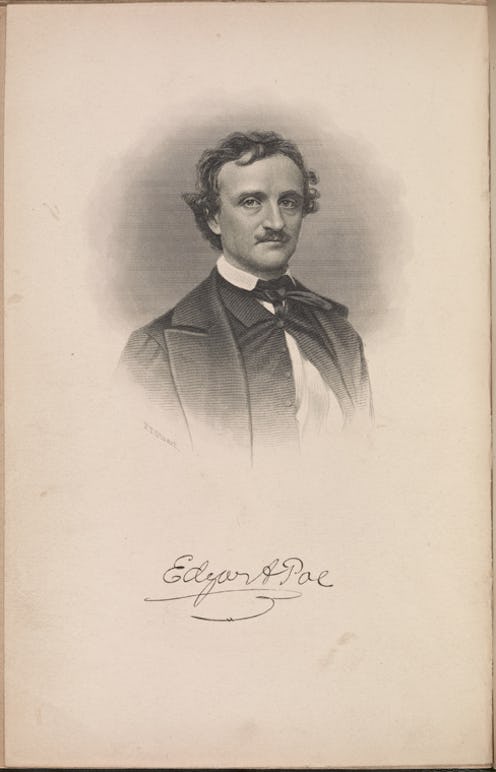Books
No One Knows How Edgar Allan Poe Died — & 9 Other Strange Facts About The Mystery Writer
January 19, 2018 marks mystery and horror writer Edgar Allan Poe's 209th birthday. The poet and writer died when he was just 40 years old, but he left behind a treasure trove of literary riches — terrifying short stories like "The Cask of Amontillado," lush and heartbreaking poems like "Annabel Lee" and "The Raven," and searing and innovative essays like "The Philosophy of Composition." He may be gone, but his work lives on in all of us.
Edgar Allan Poe is of particular interest to me, since I've been working on a secret project tied to the iconic author for a while now. In my forthcoming book, The Raven’s Tale, out in Spring 2019 from Abrams Books, I write about Edgar Allan Poe’s teenage years and his complicated relationship with his muse.
In writing this book, I had to separate the myths from the truths to paint a picture of a young writer finding his way. That meant doing a lot of research about the enigmatic poet. Over the course of that research, I learned so many fascinating things about Edgar Allan Poe. Here are 10 strange and startling facts about one of America's most famous and beloved mystery and horror writers:
1Edgar Poe turned into "Edgar Allan Poe" when he was three.
Originally, Poe didn’t have a middle name, or if he did, no record of it exists. Shortly before his third birthday, Poe’s parents died, and he was taken in by a wealthy couple in Richmond, Virginia: John and Frances Allan. They christened the boy “Edgar Allan Poe.”
2Poe called himself "Eddy."
The name "Poe" instantly conjures up images of madmen entombing victims inside walls and ravens perching above chamber doors, and "Edgar" has a nice, Gothic ring to it. Yet in letters penned to the women he loved, Poe often referred to himself as "Eddy" — a decidedly more boyish and casual moniker.
3Poe was an athlete.
One might assume that an author famous for his tales of the macabre would have spent his teen years as an angsty Goth boy. While that’s true to an extent, young Poe was also known to compete in running, boxing, and long jump events. When he was fifteen, he achieved local fame by swimming six miles up Virginia’s James River.
4Poe was engaged to his teenage girlfriend—twice.
When he was twenty-seven, Poe married his much-younger cousin, Virginia Clemm, but Virginia was not Poe’s first fiancée. That title goes to Sarah Elmira Royster of Richmond, who accepted Poe’s marriage proposal when he was seventeen and she was fifteen. The young couple never married (I reveal the reason why in The Raven’s Tale), but they reunited and became engaged again in 1849, just weeks before his death.
5Poe was a "beautiful boy."
Despite the iconic photographs of a morose-looking Poe with bags beneath his eyes, people who knew him described him as handsome. Admirers especially noted his striking eyes, which are said to have been gray, blue, hazel, or even violet. Sarah Elmira Royster called him “a beautiful boy.” One of his college friends, Miles George, described him as “most attractive.”
6The mustache didn’t appear until later in life.
Poe didn’t start wearing his famous mustache until around 1845, four years before his death at the age of forty. Paintings of Poe from his pre-mustache days scarcely look like the man with the furry upper lip who peers out from Poe merchandise.
7A rival invented his madman reputation.
Two days after Poe’s death, the New York Daily Tribune published an obituary written for him by a man who called himself “Ludwig.” Among other claims, the article said of Poe, “He walked the streets, in madness or melancholy, with lips moving in indistinct curses.” In reality, Ludwig was Poe’s bitter rival Rufus Wilmot Griswold, a writer, editor, and literary critic—one of the many enemies Poe made as a result of his own work as a critic. In 1850, Griswold published the first biography of Poe, “Memoir of the Author,” a scathing piece filled with fabrications and forged letters that haunt Poe’s reputation to this day.
8Poe was not an opium addict.
Many of Poe’s protagonists used opium, but the myth that Poe himself was a drug addict probably originated in 1845 when a reviewer compared his work to “the strange outpourings of an opium eater.” Two physicians who knew him stated that they never saw any indications of Poe using the drug—and one of those two men, Dr. Thomas Dunn English, hated Poe as much as Rufus Wilmot Griswold did!
9His teenage crush on his friend’s mom led to one of his greatest love poems.
As a young teen, Poe frequently fell in love with Richmond girls, yet none of those crushes compared to his infatuation with Mrs. Jane Stith Stanard, the mother of one of Poe’s school-friends. Mrs. Stanard died when Poe was fifteen, and by all accounts her death affected him deeply. He stated that he wrote his poem “To Helen” for Mrs. Stanard, whom he called “the first, purely ideal love of my soul.”
10No one knows how Poe died.
A stranger found Poe in a semiconscious state in a Baltimore tavern on October 3, 1849. Poe died four days later. The tavern served as a polling site, and Poe may have been a victim of a form of voting fraud called “cooping” that involved ruffians pulling men off the street, plying them with alcohol, and forcing them to vote for a candidate multiple times while dressed in disguises. Theories about the cause of Poe’s death include alcohol, rabies, a brain tumor, and murder, but the actual explanation for his demise remains his greatest mystery.
